If you play a standard chess game on a normal $8 \cdot 8$ chess board with the usual rules: How many different "board representations" can exist?
Upper bound: Well, you have 16+16 = 32 chess pieces and 64 fields, so $\frac{64!}{32!} \approx 4.8 \cdot 10^{53}$ is an upper bound. This would mean that all chess pieces are distinguishable (e.g. white knights are not distinguishable) and you can distribut them freely accross the field (white pawns can never be in the first row).
Lower bound: If you look only at the pawns, you can imagine them as a number in base 3 (they can not move, move one in front or move two in front). You have 16 pawns, so $3^{17} \approx 1.3 \cdot 10^8$ is a lower bound.
I would also be happy with the number of different game situations (which is higher, as you might care of the possibility of castling, promotion or capture).
I guess the explanation will not be easy, so please provide a source.


Best Answer
$\left(56^{16}\times2\right)^2 =$ number of possible outcomes, right?
Each row of pawns can be in every place except the first row, so I thought of it as $4$ separate superimposed boards where the first two rows of two of the boards were removed [because pawns can't travel backward] then I multiplied the number of board-spaces to the 16th power because that's the number of states that a given board-square can be in at any given time, then I squared the answer to account for the fact that pieces can go missing overtime [because that's how you play].
These are my first thoughts however, it may also be the sum of $\left(56^8\times2\right)^2$ and/plus $\left(64^8\times2\right)^2$. I'm trying to approach it as an information theory problem (like an integrated circuit) but instead of bits-per-chip I'm trying (and probably failing miserably) to read it as board-square/board-space_states_per_board, it's particularly challenging because half of the pieces [plus horses and bishops (Bishops or, maybe castles? The "diagonal moving dudes")] are restricted to never being able to reach certain spaces, so if we could: subtract those from that piece's version of the board; think of the board as a binary data equation where each valid board-square was considered as being able to be in one of 3 states (yours the enemy's, or empty); add that data to equations that had those piece-states removed from them, and then subtract one from the total [because there will always be one piece left: therefore: meaning that the outcome where all spaces are empty is invalid]
-Hope this helps. I for one: would also like to solve this mystery.